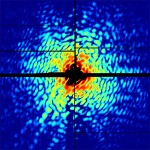International collaboration obtains the first scientific results from European XFEL

Artistic presentation of the experiment: When the ultra-bright X-ray flashes (violet) the enzyme crystals in the water jet (blue) can be reconstructed from this fluoroscopy the three-dimensional form of the enzyme (right). Image: DESY / Lucid Berlin
An international collaboration, consisting of over 120 researchers, has announced the results of the first scientific experiments at Europe’s new X-ray free-electron laser, called the European XFEL. This first study reveals a previously unknown structure of an enzyme, responsible for antibiotics resistance. “The ground-breaking work of the first team to use the European XFEL has paved the way for all users of the facility who greatly benefit from these pioneering experiments,” emphasises European XFEL managing director Robert Feidenhans’l. “We are very pleased – these first results show that the facility is ready to deliver new scientific breakthroughs.” The scientists present their results, including the first new protein structure solved at the European XFEL, in the journal Nature Communications.
more…


 The special collection in Nature’s Scientific Data, entitled
The special collection in Nature’s Scientific Data, entitled  The Journal of Applied Crystallography published a related collection of papers about software for free-electron laser experiments in a special virtual issue titled
The Journal of Applied Crystallography published a related collection of papers about software for free-electron laser experiments in a special virtual issue titled  Our article with the title
Our article with the title  Nature has selected the image from our paper with the title
Nature has selected the image from our paper with the title  The American Physical Society (APS) selected our paper with the title
The American Physical Society (APS) selected our paper with the title  Our paper with the title
Our paper with the title  The BBC reports about today’s most powerful X-ray laser, the LINAC coherent Light Source (LCLS) at Stanford University (California).
The BBC reports about today’s most powerful X-ray laser, the LINAC coherent Light Source (LCLS) at Stanford University (California). 
 Our article with the title
Our article with the title